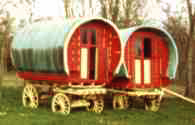
Barrel top wagons
at Bunratty Folk Park
Prior to the 1960s, travellers were a rural people moving around the countryside, generally within a limited area. Women collected food and old clothes, went from door to door selling paper flowers and other small objects, begged and told fortunes. Men made and mended tin ware, dealt in horses and donkeys, cleaned chimneys and did seasonal agricultural work.
 Barrel top wagons at Bunratty Folk Park |
Until the later nineteenth century they travelled on foot and slept in tents, barns, sheds or in the open air. From about 1870, barrel top wagons became popular with horse dealers and were widely used by 1930, though 28 per cent of travellers still lived in tents in 1960. Their lifestyle changed when motor transport eliminated door-to-door selling and tractors reduced the demand for horses, donkeys and agricultural labour. |
Social welfare saved them from destitution then, but they adapted to change, left the countryside for towns and cities and many became dealers in scrap, antiques, furniture and horses. Some wealthy traveller groups came to dominate others. Fewer than 5 per cent of traveller families lived in houses in 1960 but by 1980 more than half were either housed or were living in chalets or trailers on serviced sites.
Travellers have their own language called Shelta, Gammon or Cant, an interesting variation on Irish.
|
Travellers' distinctive way of life, values, culture and traditions manifest themselves in Traveller nomadism, the importance of the extended family, the Traveller language and the organisation of the Traveller economy ...Their story-telling, singing and music tradition are distinctive and especially worthy of note. |
Their lifestyle is traditional to the travellers and many resist change in spite of the problems caused by hazards to health and by the prejudices of settled people. According to a 1994 survey there were over 22,000 travellers belonging to 4,083 families living in Ireland. An estimated 15,000 travellers of Irish descent were believed to be living in Britain and about 10,000 in the US.
The life expectancy of traveller women is twelve years less than that of settled women and for men it is ten years less. 95 per cent of travellers die before 55 years of age and only 2 per cent live to be over 60. Many traveller women marry and give birth in their teens. Traveller birth rates are amongst the highest in Europe and the average family size was eight children in the 1980s, though the still-birth and infant mortality rates are twice to three times those of the settled population.
Travellers have set up their own support and discussion groups. Several commissions and inquiries established by the Irish government and by voluntary groups have changed from working for travellers to working with them and hearing their voices. Pre-schools were provided to give their children a 'head start' and Traveller Training Centres set up to help adults obtain employment.
Traveller women have achieved much and a few became celebrities. Margaret Barry became a famous singer. Nan Donahue had her amazing story told in book form by Sharon Gmelch and Ellen Mongan became a member of Tuam Town Commissioners.
| Being a Traveller follows from the generations. It's in our background. I'm proud I'm a Traveller - you feel free. ... I don't think Travellers should die out - they should always be there. We've our own values and traditions - tinsmiths, markets and begging. They should be kept going. Traveller children can be reared with a language no one else can understand. Kathleen McDonagh quoted in Pavee Point website. |
The Equal Status Act 2000 prohibits discrimination on nine grounds: gender, marital status, family status, sexual orientation, religion, age, disability, race and membership of the traveller community.